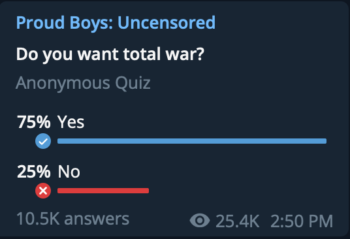Last Friday, Donald Trump Jr. announced that he had joined Telegram, and called on others to follow suit.
“Big Tech Censorship is getting worse and if these Tyrants banned my father, the President of the United States, who won’t they ban?” Trump Jr. wrote on Twitter. “We need a place that I can connect to you guys that respects Free Speech. That’s why I joined Telegram.”
Now approaching 900,000 subscribers, Trump Jr.’s Telegram channel is among the most popular in conservative circles on the platform. His move to the popular messaging app is part of an ongoing exodus of conservatives and far-right activists from mainstream social media platforms. Some did so to make a statement about Big Tech’s power over online speech, while others were forced to make the move after being banished from platforms like Twitter, Facebook, and YouTube.
Among those who joined Telegram this month were popular conservative voices like Ben Shapiro, Dan Bongino, and Candace Owens, as well as politicians with ties to QAnon such as Reps. Marjorie Taylor Greene, Lauren Boebert, and Madison Cawthorn. Conservative media sources such as The Epoch Times, Breitbart, PragerU, The Daily Wire, Right Side Broadcasting Network, and The Blaze also have accounts on Telegram. The app is home to countless far-right extremists, many of whom have used their publicly accessible channels to incite violence, radicalize disenfranchised readers, and spread propaganda and disinformation with the intention of heightening political tension.
“Welcome newcomers to the darkest part of the web,” Proud Boys leader Enrique Tarrio wrote on his public channel as well as the official Proud Boys channel. “Most chats are not moderated. You can be banned for spamming and porn. Everything else is fair game.”
While Telegram has come under fire for harboring far-right extremists and ultra-nationalists, the app has also been hailed as an essential tool for democratic movements around the world. It is this ideological dichotomy—liberating yet problematic—that makes Telegram a unique, if not controversial digital entity.
A Tool for Resistance
Founded in August 2013 by brothers Nikolai and Pavel Durov—the pioneering duo who founded VK, the popular Russian social network that serves as an alternative to Facebook—Telegram Messenger is a cloud-based instant messaging application that also provides end-to-end encryption for video calling and Voice over Internet Protocol. Unlike its competitor WhatsApp, which is owned by Facebook, Telegram is a cloud-based messenger with seamless sync, which means a user can access their account from several devices at once.
The Durov brothers started Telegram as a research project with the intention of creating something “really secure and fun at the same time.” While attempting to launch the app, Pavel Durov—a staunch libertarian with a net worth of $3.4 billion—found himself on the wrong side of the Kremlin when he refused to block Russian opposition leader Alexei Navalny’s VK page or hand over data on Ukrainian VK users. Faced with pressure from the Russian government, which he claimed forcibly took over VK, Durov sold his remaining shares in VK and fled Russia. After attempting to set up Telegram’s offices in Berlin and Singapore, Durov eventually settled on Dubai, where his team is currently based.

Despite Durov’s self-imposed exile, Telegram was an immediate success and has continued to rise steadily in popularity over the years. By October 2013, Telegram announced it had reached 100,000 daily active users. Six months later, the figure had risen to 15 million active users, and by December 2014, Telegram crossed 50 million active users, generating approximately 1 billion daily messages. As of January 2021, Telegram has more than 500 million monthly active users and is one of the 10 most downloaded apps in the world.
Telegram also allows users the ability to create public or private groups of up to 200,000 people and channels for broadcasting to an unlimited audience. It provides end-to-end encrypted “secret chats” between two online users, which proved useful to opposition movements and activists in various authoritarian countries, including China, Iran, Russia, Belarus, and Bahrain.
In July 2015, China blocked access to Telegram for providing a platform to Chinese human rights lawyers who criticized the Chinese government and the Communist Party of China. A state-run newspaper later made baseless claims that the lawyers were aided by “legal professionals” on Telegram, who “planned and organized” their activities. Several other countries followed suit, including Iran, which temporarily restricted Telegram during the anti-government demonstrations that took place in December 2017. An Iranian imam also declared Telegram as “haram,” Arabic for forbidden.
In April 2018, Telegram was banned in Russia after the organization refused to grant the Federal Security Service access to encryption keys needed to view user communications as required by the Yarovaya Law, counterterrorism legislation passed in 2016. This legislation requires internet companies operating in Russia to provide authorities with “information necessary for decoding” their users’ messages, in effect transforming the companies into participants in the government’s mass surveillance machine.
Telegram refused to comply with Russia’s demand to weaken the security of its service, which led to Moscow’s Tagansky District Court issuing a ruling to block access to the messaging app. At the time, Telegram had close to 10 million users in Russia and approximately 200 million worldwide.
However, by 2020, the Russian government had reversed course; in April, it began using Telegram to spread information regarding the coronavirus pandemic, and by June, the ban was lifted after Telegram agreed to “help with extremism investigations.”
Then on Aug. 9, 2020, thousands of demonstrators took to the streets across Belarus to protest the reelection of longtime Belarusian President Alexander Lukashenko—often referred to as Europe’s “last dictator”—who has ruled the country since 1994. Lukashenko claimed to have won a landslide victory with more than 80 percent of the vote, which ignited mass protests with demonstrators declaring the election rigged and calling on Lukashenko to resign.

As the protests morphed into a national movement, Telegram emerged as an essential tool for opposition activists, many of whom relied on the app to counter government propaganda, rally protesters, and broadcast news. Lukashenko’s government was aware of Telegram’s pivotal role during its 2020 election cycle and attempted to intimidate Telegram channel administrators by arresting some and placing others on the State Security Committee’s list of “persons involved in terrorist activities.”
The Belarusian government even went so far as to start their own state-run Telegram channel, which was used to post propaganda videos of Lukashenko brandishing rifles and commanding his security forces. By hosting their propaganda on Telegram, the Belarusian government acknowledged the messaging app’s influence as a potential news source and media platform.
“How can you stop these Telegram channels? Can you block them? No,” Lukashenko told reporters in September 2020. “Nobody can.”
Telegram remains an essential app for countries with limited access to privacy or freedom of expression and has continued to gain popularity around the world. It saw yet another surge in popularity in January 2021, adding 75 million new users as part of the fallout of WhatsApp’s disastrous privacy change and a crackdown by other platforms following the Jan. 6 Capitol insurrection. As a result, Telegram is currently the most downloaded app in the Google Play Store.
However, the popular messaging app has also gained favor among far-right extremists, many of whom migrated to the app as part of a digital exodus from mainstream social media.
The Digital Migration
“Tell all of your normie friends to get their asses onto Telegram,” wrote Proud Boys: Uncensored, a channel linked to the far-right, neo-fascist Proud Boys. “And exchange phone numbers with your tribe, if you haven’t already.”
The post was part of a common theme among far-right groups following the Jan. 6 Capitol insurrection, which saw a mob of Trump supporters storm the U.S. Capitol in a bid to halt Congress’s certification of electoral votes and to overturn the 2020 presidential election result. Insurrectionists broke into congressional offices, including that of House Speaker Nancy Pelosi, while others attempted to break into the House chamber while members of Congress were still inside.
In the aftermath of the shocking attack on U.S. democracy, Twitter permanently suspended more than 70,000 accounts associated with the far-right QAnon conspiracy theory. The company also banned Donald Trump’s personal Twitter account after the former president incited his followers to march on the Capitol. Other social media platforms like Facebook cracked down on violent rhetoric and election misinformation, while Amazon removed Parler, an alternative social media platform popular among the far-right, from its cloud hosting service, rendering it homeless on the internet.

Aware that their social media platforms of choice were no longer viable options, far-right activists and extremists turned to alternatives such as Gab, whose digital infrastructure struggled to keep up with the onslaught of user sign-ups, and Telegram, which promised sparse content moderation, end-to-end encryption, secret chats, and stable tools for mass communication. Telegram was particularly popular due to its stability and its ability to host public channels with unlimited subscribers, making it an ideal tool for broadcasting information with minimal regulation.
Prominent QAnon channels, white supremacist groups, and Proud Boy channels saw their followings grow exponentially in the aftermath of the Capitol insurrection. Some QAnon channels doubled their followings in 24 hours, while new ones emerged with thousands of new followers overnight.
Of the 26 far-right Telegram channels that Right Wing Watch monitored prior to the insurrection, 25 of them saw significant gains to their subscriber count. QAnon channels grew by an approximate 1,250,000 followers combined, including new channels for QAnon celebrities Sidney Powell and Lin Wood, which accounted for approximately 1 million followers.
The various Proud Boys channels collectively gained more than 100,000 new followers, including the official Proud Boys channel, which grew to nearly 37,000 subscribers.
“Hail Durov, the only CEO who respects his users,” wrote the Proud Boys: Uncensored channel, which is reportedly operated by the leader of the New Hampshire chapter of the Proud Boys, Todd M. Clark.

As far-right activists and extremists completed their digital migration to Telegram, there was a noticeable increase in disturbing rhetoric as some channels celebrated the Capitol insurrection, while others stoked ethnic and racial tension. The Proud Boys were among the groups inciting more violence after Jan. 6, claiming that “the difference between a patriot and a rebel depends on who wins the war.” The channel also encouraged its followers to target politicians. It posted a clip of Sen. Lindsey Graham being harassed by an angry mob of Trump supporters at the airport with the caption, “They’re no longer safe in public … Never let these system agents know a moment of peace.”
Shortly thereafter, the “Proud Boys: Uncensored” channel polled its followers on whether or not they wanted “total war.” More than 10,500 people voted in the poll, 75 percent of whom voted “yes.”
Robert Rundo, the founder of the infamous U.S.-based neo-Nazi fight club known as the Rise Above Movement and a white nationalist propaganda outfit known as the International Conservative Community, told his followers to “take a stand” and “Make your ancestors proud.” Other European-based neo-Nazi fight clubs reveled in the chaos caused by the Capitol insurrection and encouraged their American counterparts to not back down. A neo-Nazi soccer hooligan group posted a picture of a man holding a Confederate flag while wandering the Capitol halls, along with the caption, “we put the white back in the White House.”
The NSC 131 white nationalist hate group—founded by a former member of a neo-Nazi terror group known as The Base—posted photos of stolen Capitol police gear while bragging about their role in storming the Capitol.
Among the more concerning channels were those operated by accelerationist groups. The Great Reset, which has since been taken down by Telegram, informed its followers that they were “watching a coup d’état in real time” and that those “whose who don’t capitalize on this lose big time.” The channel also encouraged its followers to “break free of the Jewish chains” and to “strike the iron while it’s hot.” “You’ll never have this opportunity again,” read one post. “Now or never.”
Another channel called on its followers to attack politicians in their homes, which they should then “loot and burn to the ground.”
“[Politicians] have families too. Make the statement loud and clear that WE ARE EVERYWHERE,” read the accelerationist post. “The only way to kill these snakes is to slit their throats while their heads are turned.”
Several groups also began posting guides for building armor, weapons, and for packaging and vacuum-sealing meals for long-term storage. Others posted ambush tactics and advice for launching a citizen uprising against the U.S. government.

“Do not meet up with internet friends for this,” one publicly accessible channel wrote. “Gather your local trusted militia and do what you must to save this country and our people from their hellish claws that clamp down on the souls of us all. God willing we see a bright future, and God willing we are the ones to make it happen.”
“Stay Strong, Stay Armed, and Stay in Prayer.”
A Double-Edged Sword
Over the years, Telegram has proven to be a pivotal tool for opposition movements and citizen uprisings in places like Hong Kong, Belarus, and Russia, among others. Telegram channels drove citizen engagement, self-organization, and gave voice to citizens who have long been suppressed by the state. In many ways, Telegram became a form of digital resistance, allowing masses to successfully oppose governments and their mass surveillance technology.
However, Telegram’s commitment to freedom of speech and internet privacy is a double-edged sword due to its popularity among jihadists and other extremists. ISIS members used Telegram to plan the 2015 Paris attacks, the 2016 Christmas market attack in Berlin, and the St. Petersburg attack that killed 15 people in April 2017. And while Telegram has since cracked down on ISIS-controlled channels—it shut down approximately 80 channels in the wake of the Paris attacks and has since removed hundreds more—its regulatory action is considered lax in comparison to that of mainstream social media platforms such as Twitter.
Faced with mounting international pressure to resolve its terrorism problem, Telegram worked with Europol in 2019 to expand its terrorist content detection efforts, which resulted in the removal of 43,000 terrorist-related bots and channels. Telegram’s coordinated crackdown on terrorism has since hampered ISIS’ propaganda network and may have a long-lasting effect on the terror group’s digital footprint.
The popular messaging app took a similar approach in the wake of the Jan. 6 Capitol insurrection. Telegram founder Pavel Durov announced that his company has taken action against hundreds of accounts that were calling for violence.
“In early January, the Telegram moderation team started to receive an increased number of reports about US-related public activity on our platform,” Durov wrote. “The team acted decisively by clamping down on US channels that advocated violence. Thanks to these efforts, last week our moderators blocked and shut down hundreds of public calls for violence that could’ve otherwise reached tens of thousands of subscribers. The team continues to process reports from users in addition to proactively removing content that directly incites violence.”

Among the channels that Right Wing Watch can confirm were banned by Telegram include accelerationist channels such as The Great Reset and Accelerationist Revival as well as fascist and neo-Nazi outposts such as Eco-Fascist Central, Union 88 Gas Co, Hatelab, and The Gray Hour. The company also banned a neo-Nazi channel dedicated to sharing audiobooks of banned extremist material such as Adolf Hitler’s “Mein Kampf” as well as the manifestos of mass shooters like the Christchurch shooter. All the aforementioned channels were home to a cesspool of extremists inciting violence, race wars, and political chaos.
Yet despite Telegram’s recent action, there are still countless extremist channels publicly accessible on the messaging app. Hundreds of white supremacist, neo-Nazi, and anti-Semitic channels continue to flourish. Dozens of QAnon channels are operating with thousands of new subscribers, while the Proud Boys continue to communicate with their audience despite their well-documented calls for violence.
The continued existence of far-right extremism on Telegram reflects the company’s lackluster efforts in curtailing extremist content. While Telegram has long presented itself as a bastion of free speech, others have argued that the company’s blind commitment to that ideal inevitably made it vulnerable to zealotry.
“[Telegram’s] technology is agnostic,” said Oren Segal, the vice-president of the Anti-Defamation League’s Center of Extremism. “It is about the use of that technology. The same tools or features on Telegram that enable positive interactions for some are also the tools that enable extremism to thrive.”
There is also a concern that far-right activists will use Telegram to radicalize disillusioned QAnon adherents who have lost faith in their movement following President Joe Biden’s inauguration on Jan. 20. One post from the Proud Boys: Uncensored Telegram channel called on their subscribers to “be gentle to our fellow travelers, telegram anon. It is up to you and I to lead them to the logical and truthful conclusion of their journey. Don’t chase them off with anger or sarcasm. Right now they are looking for real answers. You were probably them once upon a time.”

Given that Telegram remains a safe haven for a wide range of far-right activists, a Washington-based non profit group called “Coalition for a Safer Web” sued Apple, demanding the companies remove Telegram from its App Store. Marc Ginsberg, a former U.S. ambassador, later sued Alphabet Inc. in an attempt to press the company to remove Telegram from its Google Play Store. While Telegram’s removal could arguably be seen as a victory for dictators around the world, the threat of capitalistic pressure might be the only way to affect change in Telegram’s policies.
“It is not unreasonable for people to demand or expect that incitement to violence will be curtailed; that hate speech would be curtailed,” Segal explained. “This is not about differences of opinion. This is not about silencing conservative or liberal voices. This is about taking a position against the type of content that drives so many of these extremist and violent actions we’ve seen on the ground. This is as low-hanging fruit as it gets.”






